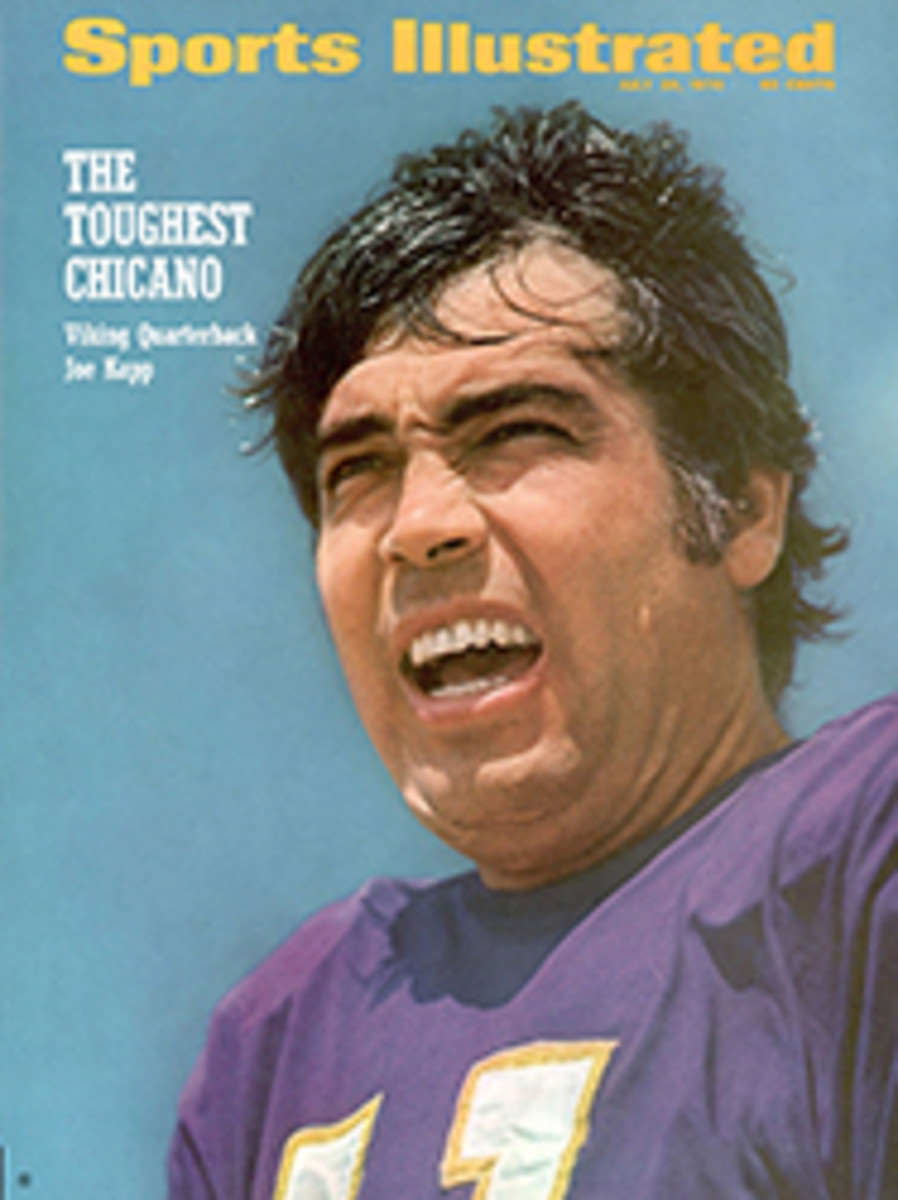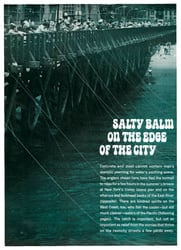
SCORECARD
DEADLY MERCURY
The latest and most frightening pollution problem has to do with mercury. Last week Alabama banned fishing in 51,000 acres of water, including the Tennessee River, and Governor Albert Brewer asked President Nixon to declare portions of the state federal disaster areas, all because of mercury in the water. Federal officials admitted that waters in at least 13 other states are also contaminated. In New York, authorities warned people against eating fish from either Lake Champlain or the St. Lawrence River. Canadian provinces barred fishing in a number of lakes. Some public water supplies on both sides of the border may be in peril.
Highly poisonous to living creatures, mercury is a heavy metal that can persist in the environment for years. Between 1953 and 1960, 110 people died or were disabled in Japan after eating fish caught in Minamata Bay, into which a plastics plant had been discharging mercury. A very slight amount can cause headaches and numbness, and not very much more can bring about impairment of speech and vision or even severe emotional disturbances. The expression "mad as a hatter" stems from the 19th century when a high incidence of hat-makers became mentally ill because of their continual contact with mercury used in treating felt.
The mercury in our waters appears to come from three major sources: 1) farmlands on which seeds and trees have been treated with mercury to prevent fungus, 2) chemical and plastic plants, 3) paper mills, which use mercury to inhibit the growth of slime in the process waters. In a way, the most shocking fact about the current mess is that its existence was not discovered by an antipollution official but by a Norwegian graduate student at the University of Western Ontario. The student, Norvald Fimreite, found that pheasants and red-tailed hawks in Alberta were contaminated with mercury, so much so that the provincial government has banned hunting. Fimreite then found that fish taken from Lake St. Clair, between Michigan and Ontario near Detroit, were also mercury-laden. It turned out that a chemical plant had been discharging 200 pounds of mercury a day into the lake. Then, and not until then, did public officials wake to the problem.
It makes you wonder just who the hell is minding the environmental store.
IT WAS EASY
Eddie Charlillo, a 58-year-old Clevelander, had a hole in one this spring on a local golf course. Ten years ago, in a local bowling alley, Eddie Charlillo rolled a 300 game. Pulling off a hole in one and a 300 game is a dreams-of-glory parlay that for the weekend athlete ranks right up there with Bobby Jones' grand slam. "I'm sure it's been done before," Charlillo said modestly, and then added, "but I've never heard of anyone else who did it." Asked which was the more difficult, Charlillo said, "Oh, the 300, by far. On the hole in one you don't know what's happening. When you see the ball go in you just jump."
TAPE JOB
No matter who wins what this year, fans will be able to buy their heroes in action—or, at any rate, buy a record of the big moments of the season. Fleetwood Recording Co. of Revere, Mass. has made 14 such records, with Goal Bruins on top of the charts at the moment. That one, about Boston's Stanley Cup champions, seems likely to break the sales record of The Impossible Dream, a golden oldie about the Red Sox and their astonishing pennant victory in 1967.
Right now, Vincent Giarrusso of Fleetwood has his eye on baseball and has been collecting tapes on the Orioles, Tigers, Yankees and Twins in the American League and the Reds, Mets, Pirates, Cardinals and Cubs in the National. "We cover all possibilities," says partner Ray Semora. "We go through miles of radio and TV tape in our editing—games, crowd stuff, locker rooms, the whole thing. Then we narrow things down to one team. During the Stanley Cup playoffs we'd file away the tapes of each team that was eliminated until only the Bruins were left. Five days after Bobby Orr scored that winning goal we were moving records."
There have been some bombs, Semora admits. Fleetwood followed the Baltimore Colts through an entire season to produce Colt Stampede. The company was as astounded as the Colts were by the 1969 Super Bowl and had to scramble to come up with Super Jets.
CAIRO WEST
Two hunters from Gadsden, Ala., sighted what they thought were two snow geese. Each got one. One of the hunters, Ralph Farrow, gave his to his brother Randy, who ate it. The other hunter, Rick McCallie, puzzled over the brilliant markings of the bird he had shot: pale buff color, wings of black and brown and iridescent green, with black and white undersides. He knew it was no common fowl in Alabama, but, he said, "I had no idea how rare it was." At a meeting of Ducks Unlimited a visiting authority was unable to identify it. At long last the National Wildlife Museum in Washington came up with a positive identification: the bird was an Egyptian goose, Alopochen aegyptiacus. A doctor in Okeechobee, Fla. was known to have some in his private aviary, but his birds were still all there. Egyptian geese travel in pairs, roost in trees, and range from Egypt and Palestine to South Africa; these strayed migrants from the war zone, said McCallie, must have "wandered thousands of miles off course." They evidently lived well in Alabama. In Africa, Egyptian geese are said to be almost inedible, but Randy Farrow reported that the one he cooked was delicious.
NOT SO SOUR GRAPES
Now that he has lost the prize bauble, Maryland basketball Coach Lefty Driesell claims he wasn't all that disappointed at not getting Tom McMillen, the 6'11" high school phenomenon who has decided to attend North Carolina. "I wasn't surprised by his decision," says Driesell. "I never did feel we had much chance of getting him to Maryland. He took a sort of 'keep away, leave me alone and let me make up my own mind' attitude, and I didn't get to talk to him more than two or three times. North Carolina had been working on him for years, so everybody else was pretty much at a disadvantage." Asked to compare McMillen with Lew Alcindor, Driesell says, "He'll score more points than Alcindor did in college, but he won't be the all-round player Lew was."
Even though he missed on McMillen, superrecruiter Driesell came up with four top prospects: Len Elmore and Japeth Trimble from Power Memorial in New York (Alcindor's old school), Mark Cartwright from Chicago and Rich Perac from Pittsburgh. So, Lefty has something left after all. Like hopes for a national championship in a few years.
APPROPRIATE
Bill Bunker of the Florida Department of Commerce turned in a neat 116 during a writers' golf outing in Florida the other day and managed to win the Calloway System tournament. His most impressive hole was the 12th, a 560-yard, uphill, doglegged, trap-guarded, tree-bordered par 5, which he did in 18. Lying 16, Bunker bent over a six-foot putt and muttered, "I've got to make it. I've never had more than a 17 on a hole in my life." Naturally, the ball rimmed the hole and stayed out.
None of this would be particularly striking news for the duffers of the world except for a comment from Doc Giffin, who was playing in the same foursome. "Bunker," said Giffin, "beats Steve Spray and L. V. Shank in having the most appropriate built-in name for his golf style."
AMAZING
Bill Landers, who writes The Webfoot Line, an engaging monthly newsletter put out by the University of Oregon's athletic department, had this to say about one of the athletic fields at the school: "Howe Field is receiving a fantastic new covering as it enters the brave new world of the '70s. This new product has some amazing characteristics, not the least of which is its ability to regenerate itself, apparently indefinitely. The parts that are damaged or soiled can be cut off (a mechanical device has been developed to accomplish this task) and new parts automatically replace them. This new material is called 'Grass.' It is the same covering used by New York City in Central Park during the tourist season.
"In the base paths of the field a material called 'Dirt' has been used. It is rich brown in color and blends beautifully with the Grass. It is easy to smooth out between innings and when players slide on it the particles of the Dirt tend to roll along with the player, thus softening the abrasiveness of the slide. One slight drawback to Dirt is its tendency to become sticky and gummy when combined with water.
"Many people will be watching the Oregon experiment. If it proves to be practical, similar installations will undoubtedly spring up all over the country."
ILLUSTRATION
THEY SAID IT
•Bob Goalby, 1968 Masters' champion, on golfers as athletes: "We drink too much. We live too good. I don't consider myself an athlete because I'm not in good shape. Arnie Palmer's not in good shape. Bob Murphy sits on a walking cane between shots. Julius Boros could be one hell of a player, but he's 20 pounds overweight and he doesn't want to fight it. Gary Player is an athlete. He works at it."
•Glenn Beckert, Chicago Cub second baseman, on the recent melee between the Cubs and the Pittsburgh Pirates: "I was down on the ground wrestling Richie Hebner. I finally grabbed his long hair and was pulling in one direction while somebody else was pulling the other way on his legs. He yelled, 'My moss, my moss, let go of my moss!' "

